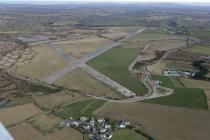Content can be downloaded for non-commercial purposes, such as for personal use or in educational resources.
For commercial purposes please contact the copyright holder directly.
Read more about the The Creative Archive Licence.
Description
Aerial photograph of St. Davids Airfield, Whitchurch, Solva. Taken on 02 March 2010.
St David's Airfield, Solva consisted of thirty diamond-shaped hard-standings which were placed in five clusters around the perimeter, the most extensive clusters being to the north. The bomb store and fuel store were also placed on the northern perimeter, with the bomb dump further to the north. The south side of the airfield was the area determined for a watch office to pattern 12779/41, living quarters, and various maintenance buildings formed from Nissen or Maycrete huts. Provision for four T type hangars was also made on the southern perimeter, but only three were erected. Three Blister hangars were also built. The airfield had three runways 1801m (5910ft) long, 975m (3200ft) long, and 1088m (3570ft) long, established in a triangular pattern. The majority of buildings have now been demolished, but the runways and taxi-areas remain.
Event and Historical Information:
St Davids was initially intended to be a base for the US Navy with Consolidated Vultee PB4Y Liberators, but in September 1943 it opened for RAF Coastal Command units instead. The first aircraft were Boeing B17 Flying Fortresses from 206 and 220 squadrons. 517 Meteorological Squadron brought two Handley Page Halifax bombers in November 1943, followed in December by the Halifaxes and Hawker Henleys from 58 and 502 squadrons. 517 Squadron moved to Brawdy when it opened in February 1944. However, 58 Squadron was in residence at St David's until August 1944, and 502 Squadron until September 1944. 202 Squadron returned between June-September 1945 along with 53 Squadron (both equipped with PB4Y Liberator aircraft). The station's headquarters was moved to Brawdy along with the sick bay and workshops facilities in November 1945. St Davids was then placed into care and maintenance before both airfields were passed to the Royal Navy on 1 January 1946. Between 1955 and 1958, whilst Brawdy was being modernised to accept jet aircraft, St Davids was used by the Fleet Requirement Unit (FRU) operated by Airworld Ltd.
Sources include:
Defence of Britain Project
Jones, I, 2007, Airfields and Landing Grounds of Wales: West, pg168-175
Phillips, Alan, 2006, Military Airfields Wales, pg 207-212
Smith, David J 1982 Action Stations 3: Military Airfields of Wales and the North West, pg 154-6





Do you have information to add to this item? Please leave a comment
Comments (0)
You must be logged in to leave a comment